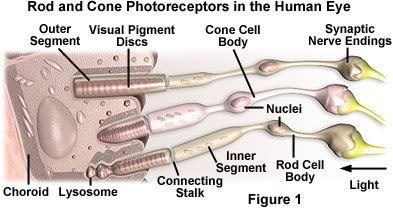Ραβδία – Κωνία Rods – Cones
Όπως είδαμε https://xromata.com/?p=1373 η λειτουργία της όρασης βασίζεται στα ραβδία και στα κωνία, όπου τα μεν πρώτα αντιλαμβάνονται την αμυδρότερη επέλαση του φωτός, τα δε δεύτερα ερεθίζονται με περισσότερη ποσότητα φωτός, το οποίο και διαχωρίζουν σε χρωματικές ακτινοβολίες.
Ας δούμε τις διαφορές μεταξύ αυτών των δυο φωτοσυλλεκτών.
Διαφορές μεταξύ ραβδίων και κωνίων
|
Ραβδία |
Κωνία |
|
Χρησιμεύουν για την σκοτοπική όραση. Σκοτοπική καλείται η όραση που εκτελείται από τον οφθαλμό κάτω από συνθήκες χαμηλού φωτισμού. Ετυμολογικά ο όρος σκοτοπική όραση κατάγεται από τις Ελληνικές λέξεις σκότος και –οπία (σημαίνουσα την κατάσταση όρασης). |
Χρησιμεύουν για την φωτοπική όραση. Φωτοπική καλείται η όραση που εκτελείται από τον οφθαλμό κάτω από συνθήκες καλού φωτισμού Στον άνθρωπο και σε πολλά άλλα ζώα δια της φωτοπικής όρασης επιτυγχάνεται η χρωματική αντίληψη με την μεσολάβηση των κωνίων. |
|
Πολύ φωτοευαίσθητα. Ευαισθητοποιούνται με το διασκορπισμένο τριγύρω τους φως. |
Όχι τόσο φωτοευαίσθητα. Ευαισθητοποιούνται μόνο από το φως που πέφτει κατευθείαν επάνω τους. |
|
Η έλλειψή τους επιφέρει νυκταλωπία, μια κατάσταση που κάνει δύσκολη η αδύνατη την όραση σε επίπεδα χαμηλού φωτισμού. Η νυκταλωπία μπορεί να υπάρχει εκ γενετής ή να προκληθεί από τραυματισμό ή κακή διατροφή, πχ. έλλειψη βιταμίνης Α. |
Η έλλειψη κωνίων επιφέρει νομική τύφλωση. Αυτό σημαίνει ότι ένα άτομο θεωρείται νομικά τυφλό όταν διακρίνει ένα αντικείμενο σε απόσταση 6 μέτρων –με διορθωτικούς φακούς- με τον ίδιο βαθμό ευκρίνειας που ένα άτομο βλέπει το αντικείμενο αυτό, σε απόσταση 60 μέτρων. |
|
Χαμηλή οπτική οξύτητα. |
Υψηλή οπτική οξύτητα. Καλύτερη χωροταξική ανάλυση. |
|
Δεν ευρίσκονται στο βοθρίο. |
Επικεντρώνονται στο βοθρίο. |
|
Αργή ανταπόκριση στο φως, οι σκοτοπτικοί διαχωρισμοί επέρχονται με την πάροδο κάποιου χρόνου. |
Άμεση ανταπόκριση στο φως, αντιλαμβάνονται ταχύτατα τις φωτοπτικές αλλαγές. |
|
Περιέχουν μεγαλύτερη ποσότητα φωτοχρωστικής ώστε να ανιχνεύουν χαμηλότερα επίπεδα φωτισμού. |
Περιέχουν μικρότερη ποσότητα φωτοχρωστικής από τα ραβδία και χρειάζονται περισσότερο φως για να διακρίνουν ευκρινέστερα τις εικόνες. |
|
Υπάρχουν 20 φορές περισσότερα ραβδία από κωνία στον αμφιβληστροειδή. |
|
|
Περιέχουν ένα τύπο φωτοευαίσθητης χρωστικής ουσίας. |
Περιέχουν 3 τύπους φωτοευαίσθητης χρωστικής ουσίας, στον ανθρώπινο οφθαλμό. |
|
Παρέχουν αχρωματική όραση. |
Παρέχουν χρωματική όραση. |
Translated into English
Difference between rods and cones
As seen in https://xromata.com/?p=1373 function of vision is based on rods and cones, where the first ones sense the dimmest advent of light and the second ones are stimulated by much more amount of light, which is separated by them into chromatic radiation.
Let’s see the differences between these two photoreceptors.
Comparison of rod and cone cells.
|
Rods |
Cones |
|
Used for scotopic vision Scotopic vision is the vision of the eye under low light conditions. The term comes from Greek skotos meaning darkness and -opia meaning a condition of sight |
Used for photopic vision Photopic vision is the vision of the eye under well-lit conditions. In humans and many animals, photopic vision allows color perception, mediated by cone cells. |
|
Very light sensitive; sensitive to scattered light |
Not very light sensitive; sensitive to only direct light |
|
Loss causes night blindness is a condition making it difficult or impossible to see in relatively low light. It is a symptom of several eye diseases. Night blindness may exist from birth, or be caused by injury or malnutrition (for example, a lack of vitamin A). |
Loss causes legal blindness This means that a legally blind individual would have to stand 20 feet (6.1 m) from an object to see it—with corrective lenses—with the same degree of clarity as a normally sighted person could from 200 feet (61 m). |
|
Low visual acuity |
High visual acuity; better spatial resolution |
|
Not present in fovea |
Concentrated in fovea |
|
Slow response to light, stimuli added over time |
Fast response to light, can perceive more rapid changes in stimuli |
|
Have more pigment than cones, so can detect lower light levels |
Have less pigment than rods, require more light to detect images |
|
Stacks of membrane-enclosed disks are unattached to cell membrane directly |
Disks are attached to outer membrane |
|
20 times more rods than cones in the retina |
|
|
One type of photosensitive pigment |
Three types of photosensitive pigment in humans |
|
Confer achromatic vision |
Confer color vision |
admin is | Topic: λειτουργίες όρασης χρωμάτων | Tags: ακτινοβολία, αμφιβληστροειδής, αχρωματική όραση, βιταμίνη Α, βοθρίο, κωνία, μάτι, νυκταλωπία, όραση, ραβδία, σκοτοπική όραση, τυφλός, φως, φωτισμός, φωτοπική όραση, φωτοχρωστική


3 Comments, Comment or Ping
Maricruz Dobek
Hey, i think you visited my website so here i am!.I am trying to find things to improve my blog!Is it ok if i use some of the things i saw here?!
31-12-10
admin
It is ok Maricruz Dobek!
Panos
5-1-11
zoki
Youre so cool! I dont suppose Ive read something like this before. So good to seek out any individual with some original ideas on this subject. realy thank you for beginning this up. this website is one thing that’s needed on the net, somebody with somewhat originality. useful job for bringing something new to the web!
21-1-11
Reply to “Ραβδία – Κωνία Rods – Cones”